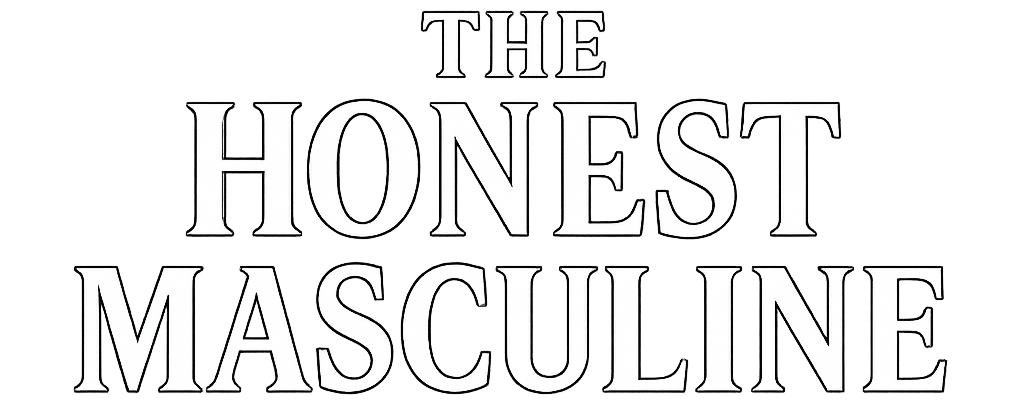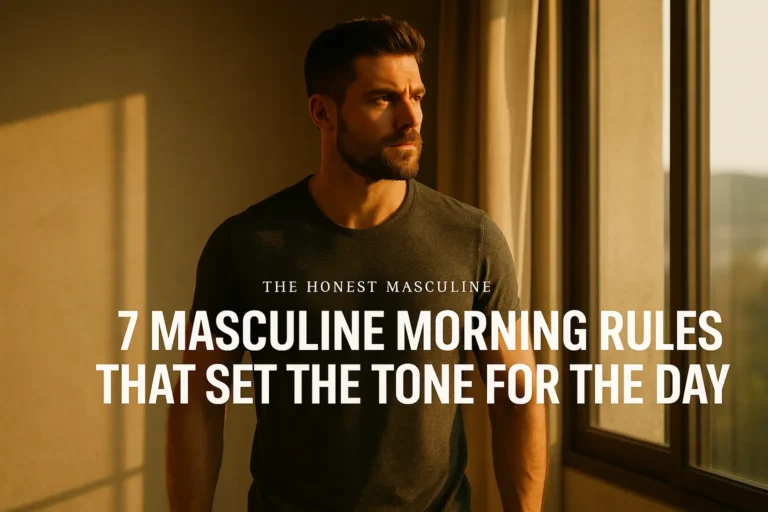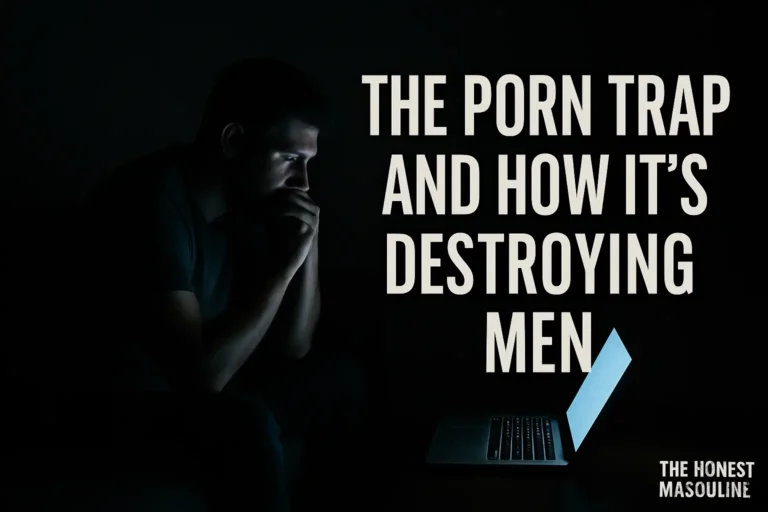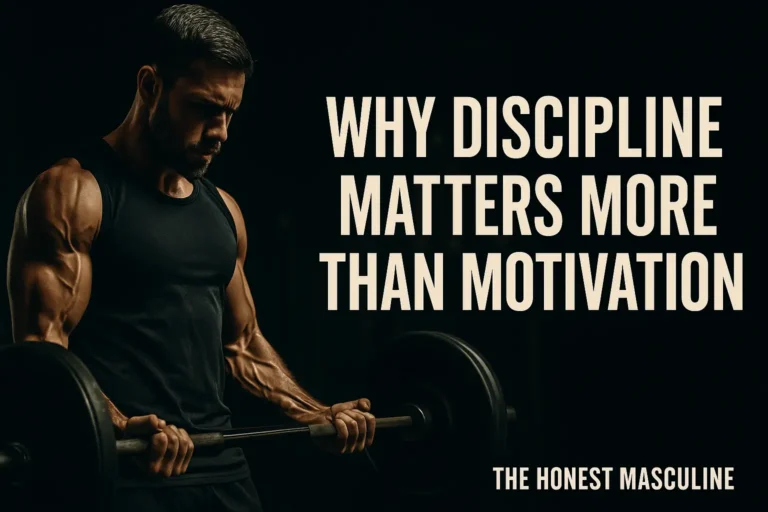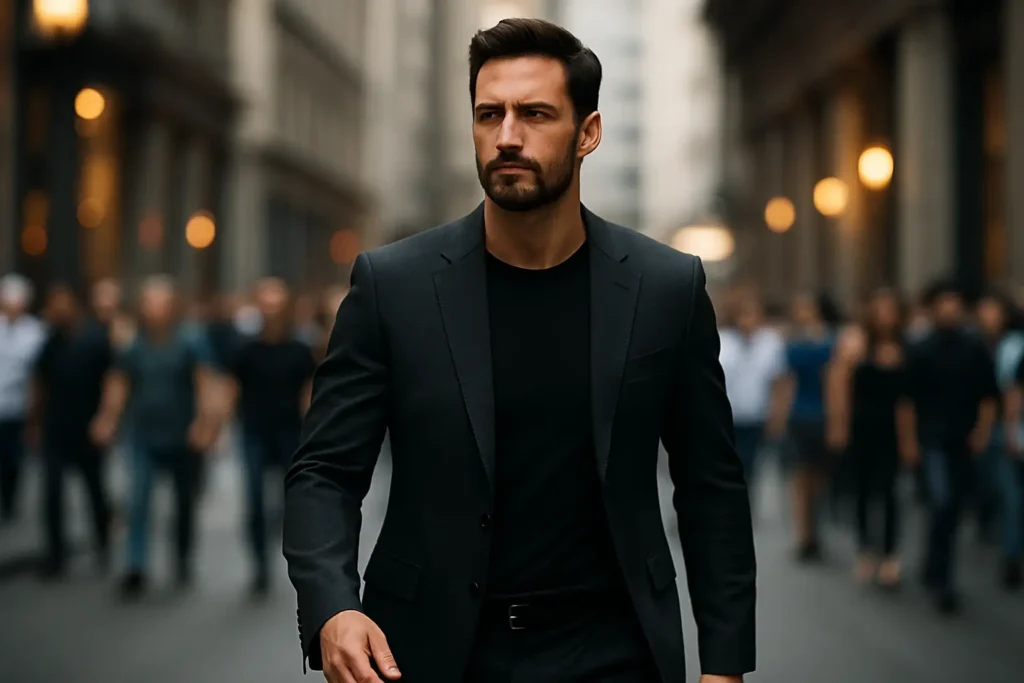
Table of Contents
The Silent Power You’ve Been Ignoring
Most men overthink what to say. They obsess about clever one-liners, debate whether their outfit is stylish enough, or rehearse how they’ll introduce themselves at the bar.
Meanwhile, the truth is staring them in the face: it’s not your words that people notice first. It’s your body.
The way you stand. The way you walk. The way your eyes land—or don’t. Your posture, your pace, your energy. All of it speaks louder than whatever comes out of your mouth.
If you slouch, fidget, or look down at the ground, you’ve already told the world you don’t trust yourself. If you walk tall, steady, and calm, you’ve already earned respect before anyone knows your name.
That’s the essence of masculine body language. It’s not a trick, it’s not about “acting alpha,” and it’s not fake swagger. It’s about presence. The kind of presence that gets felt before it gets seen.
What Masculine Body Language Really Means
Masculine body language isn’t about puffing up your chest like a cartoon character or strutting around the room desperate for people to notice you. That’s insecurity disguised as confidence, and people can smell it.
Real masculine body language is rooted in calmness and control. It’s stillness where others fidget. It’s rootedness where others shuffle. It’s deliberate movement where others are erratic.
Think of the difference between a soldier at attention and a kid who can’t sit still in class. One radiates order, the other chaos. That’s the difference between men who command respect and men who constantly chase it.
Masculine body language is economical. It doesn’t waste energy. It doesn’t over-explain. It doesn’t over-gesture. It simply exists in a way that says: I am here. I belong. And I’m not going anywhere.
Related article: What Does Masculine Frame Really Mean? (And How to Build It)
The Psychology of First Impressions
Here’s the brutal science: you’ve got less than seven seconds to make a first impression. And according to Albert Mehrabian’s famous communication model, over half of that impression comes from non-verbal cues.
That means your body language is speaking louder than anything you say. People are scanning:
- How you stand.
- Where your eyes go.
- How relaxed or tense your face looks.
- Whether you move with confidence or stumble with uncertainty.
It’s evolutionary. For most of human history, people had to decide in seconds whether a man was a threat, a leader, or irrelevant. Those instincts are still with us.
You can be the smartest guy in the room, but if your body language tells the story of a man who doesn’t trust himself, that’s what people will remember.
The Four Pillars of Masculine Body Language

If you strip it down, masculine body language rests on four core pillars: posture, eye contact, movement, and voice.
Posture: Your Silent Résumé
Your posture is announcing you long before you introduce yourself. Upright, shoulders back, chest open—that tells people you’re confident and engaged with the world. Slouched, hunched over, chin tucked—that says defeat, insecurity, or apathy.
Posture isn’t about puffing yourself up or trying to look bigger than you are. It’s about carrying yourself in a way that signals strength without desperation. It’s standing like you own your space, not like you’re apologizing for existing.
One simple way to train this: spend a few minutes each day standing with your back against a wall. Feel what tall, open posture feels like. Then bring that into your daily life until it becomes natural.
Eye Contact: The Gateway to Respect
Nothing gives away insecurity faster than darting eyes. If you can’t look someone in the eye, you’re telling them you don’t belong. On the flip side, if you stare too intensely, you look unhinged.
The masculine balance is steady, calm eye contact. You don’t look away nervously, but you also don’t cling to people’s gaze like you’re begging for validation. You see people. You hear them. You’re present. That’s it.
Movement: Slow Is Strong
Watch a man who’s nervous. He fidgets. He taps his leg. He moves quickly as if he’s trying to escape his own body. Now watch a man who’s confident. He moves slowly. Deliberately. Every step and gesture has weight.
Masculine movement is grounded. You don’t rush. You don’t stumble. You don’t explode with jittery energy. You take your time because you know you belong.
Voice and Expression: Don’t Beg
Masculine presence extends to how you speak and hold your face. A rushed, high-pitched voice screams stress. Slow down. Drop your tone. Speak like your words are worth waiting for.
Your expression matters too. Constant smiling looks needy. Twitching or overreacting shows nervousness. Masculine expression is calm and controlled. Relaxed face, neutral until you choose to reveal more.
Weak vs Strong Body Language
Weak body language is obvious once you know what to look for: slouched shoulders, arms crossed, fidgeting hands, restless legs, averted eyes.
Strong body language is the opposite: upright posture, open chest, steady breathing, relaxed hands, eyes that don’t dart away at the first sign of contact.
This isn’t just theory. Research from Harvard psychologist Amy Cuddy showed that “power poses”—expansive postures where you take up more space—increase testosterone and reduce cortisol. Translation: your body language doesn’t just project confidence, it creates it.
How Women Read Masculine Body Language
Women notice your body language before you even say hello. She sees the way you walk into the room. She feels whether your energy is steady or scattered. She knows, instinctively, whether you look like a man she could trust—or a man she should avoid.
Strong posture signals protection. Calm eye contact signals confidence. Controlled movements signal emotional steadiness. These things trigger her instincts long before she consciously analyzes you.
And here’s the harsh truth: if your body language is weak, you’ve lost before you’ve even started the conversation.
Masculine Body Language in Everyday Life

This isn’t just about dating. Masculine body language plays out everywhere.
At work, the man who shuffles into a meeting with slumped shoulders and eyes on the floor gets ignored. The man who walks in calm, upright, and steady commands attention before he even speaks.
As a father, your kids mirror what you show them. If you carry yourself like a man who’s timid and apologetic, they’ll internalize that. If you stand tall and move with grounded presence, they’ll absorb that too.
Even with friends, masculine body language changes the dynamic. Among men, respect often comes down to presence more than words. You don’t need to be the loudest. You need to be the calmest.
Building Masculine Body Language
The good news is this isn’t about genetics. You don’t need to be tall, jacked, or movie-star handsome. Masculine body language is built through practice and awareness.
Start with posture. Reset every time you catch yourself slouching. Train it until it’s automatic.
Then, practice stillness. Sit or stand for five minutes without fidgeting. Learn how to feel comfortable in silence.
Record yourself walking, talking, and sitting. It will be uncomfortable at first, but you’ll see where you look weak and you’ll know what to correct.
Work on your voice. Speak slower than you think you should. Record and listen. Lower your tone until it carries more weight.
Finally, own your space. Don’t shrink. Don’t apologize. Stand and sit like you belong everywhere you go.
The Mistakes That Kill Masculine Presence
Most men get this wrong by trying too hard. They overcompensate, puff out their chest, and strut like peacocks. That doesn’t read as confidence—it reads as insecurity on steroids.
Smiling too much to win approval kills your presence. Talking with your hands constantly makes you look nervous. Crossing your arms defensively makes you look closed off.
And the classic mistake: leaning in too much when talking to women. Nothing screams “beta” more than chasing her space instead of owning yours.
FAQ: Masculine Body Language
What is masculine body language?
It’s the way men carry themselves—through posture, movement, eye contact, and expression—that signals confidence, strength, and authority without words.
How do I show masculine energy through body language?
Stand tall, move deliberately, maintain calm eye contact, and control your voice and expressions.
What body language is attractive to women?
Confident posture, steady eye contact, calm stillness, and relaxed movements. These signal protection, strength, and emotional steadiness.
How can I fix weak body language?
Practice posture daily, train stillness, record yourself, and build awareness until masculine habits replace nervous ones.
Last Words
Masculine body language isn’t about faking it or trying to look tough. It’s about presence. It’s about showing up as a man who doesn’t need to prove anything.
Stillness. Calm. Control.
When you master these, you don’t have to beg for respect. People give it to you. Women feel it. Men acknowledge it. Life gets easier.
And the beauty is, you don’t need to say a word.

If you like my content? Let me know by Buying me a coffee. Thanks 🙂
👉Want to reclaim your life?
Join My Newsletter The Honest Masculine weekly newsletter — and you’ll get instant access to my (Masculine_Future_Manifesto). No fluff, no filters. Just raw truths about breakups, masculinity, fatherhood, and the quiet battles men face alone.
It’s for the man who’s done pretending.
